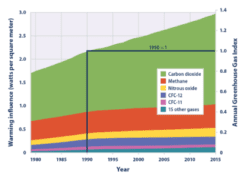This indicator measures the “radiative forcing” or heating effect caused by greenhouse gases in the atmosphere.
Figure 1 of this indicator measures the average total radiative forcing of 20 long-lived greenhouse gases, including carbon dioxide, methane, and nitrous oxide. The results were calculated by the National Oceanic and Atmospheric Administration based on measured concentrations of the gases in the atmosphere, compared with the concentrations that were present around 1750, before the Industrial Revolution began. Because each gas has a different ability to absorb and emit energy, this indicator converts the changes in greenhouse gas concentrations into a measure of the total radiative forcing (warming effect) caused by each gas. Radiative forcing is calculated in watts per square meter, which represents the size of the energy imbalance in the atmosphere.
The National Oceanic and Atmospheric Administration also translates the total radiative forcing of these measured gases into an index value called the Annual Greenhouse Gas Index (right side of Figure 1). This number compares the radiative forcing for a particular year with the radiative forcing in 1990, which is a common baseline year for global agreements to track and reduce greenhouse gas emissions.
For reference, this indicator also presents an estimate of the total radiative forcing associated with a variety of human activities from 1750 to the present. Figure 2 shows the influence of:
- Tropospheric ozone, a short-lived greenhouse gas.
- Emissions that indirectly lead to greenhouse gases through chemical reactions in the atmosphere. For example, methane emissions also lead to an increase in tropospheric ozone.
- Aerosol pollution, which consists of solid and liquid particles suspended in the air that can reflect incoming sunlight.
- Black carbon (soot), which can make the Earth’s surface darker and less reflective when it is deposited on snow and ice.
- Several other factors, like land use change, that affect radiative forcing.




